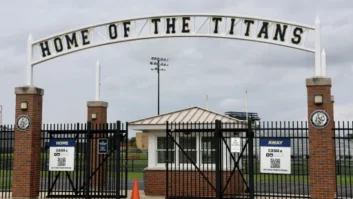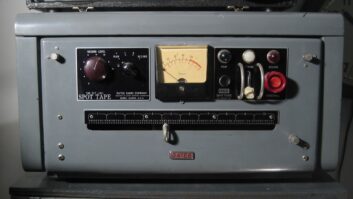
Up to $55 billion annually. That’s the estimate of value that could be created if U.S. FM stations were to add electrical appliance control messages to their data feeds. Revenue would come from utility companies remotely managing consumer power consumption via radio and be divided among various stakeholders, including the radio owners involved.
Such connectivity would allow a utility to reduce power consumption during peak periods, or instruct heaters and air conditioners to boost their usage during off-peak periods to “bank” this energy against the next high demand period.
The projection is a breathtaking one, given that the current revenue of the U.S. commercial radio industry is generally estimated to be anywhere from $13 billion to $21 billion. But it is the contention of Jackson Wang, founder and CEO of e-Radio Inc., that stations could have a big piece of that pie.
Radio World has reported about this “smart grid” company several times in the past decade and recently checked back in.
The Toronto-based firm is owner of a patented communications solution and operates wireless communications networks. Its FM receiver modules can be integrated into a variety of smart grid devices for residential, commercial and small industrial applications — water heaters, HVAC equipment and so on — using FM broadcasting as its communications platform.

A growing number of such appliances are capable of being remotely addressed now, thanks to their built-in “internet of things” data reception architecture; however, the e-Radio platform does not rely on the internet, but on those FM signals.
The company operates in the United States and Canada; it is also a member of the global RDS Forum and hopes to build a footprint in other markets. It has about a dozen full- and part-time employees and is privately held; Jackson Wang is majority owner.
The firm’s energy management approach — which Wang said has been proven feasible in field tests with radio stations and power utilities — is to send the appliance device instructions via one-way FM RDS signals as required. According to the company, its Utility Message Channel via RDS on FM can reach over 300 million people and their devices in about two seconds. This allows utilities to reduce or boost electricity usage on a near-immediate basis.
“FM RDS provides a reliable, economical and easy-to-provision one-way path to these IoT appliances,” said Wang.

“Appliances equipped with our small P2D 2045 FM receivers work immediately once activated, and generally do not require maintenance over time. In contrast, IoT-enabled appliances that rely on the internet have inherent privacy issues, are more vulnerable and failure-prone and could be disconnected any time the homeowner replaces their router.”
The company is now conducting field testing with HD Radio as well.
DRIVING DATA REVENUE?
What Wang has been telling broadcasters for some time is that all this represents an unrealized revenue opportunity for FM broadcasters.
For many stations, the data infrastructure that transmits station info such as identification and artist/song names has not produced revenue, whether we’re talking about analog RDS or digital HD Radio.
Glynn Walden knows a lot about e-Radio. In his former role as CBS Radio senior VP of engineering and now as a consultant to its successor Entercom, Walden has worked with e-Radio to coordinate demo projects. He and Wang co-chair the National Radio Systems Committee’s DRB Subcommittee, and Walden hopes to be an “active participant” in a rollout of the system on HD Radio.
He said that the problem dogging FM data is its one-way, one-to-many data transmission model.
“Every time we came up with a one-way data application that worked over HD Radio, someone came up with a solution that was deployable over a two-way channel like the internet,” he said. “It made it pretty hard to monetize HD data and earn revenue from this data channel as a result. With IoT, there could be billions of devices only in need of one-way data.”
Walden is convinced that Wang has found a way to make RDS earn money for radio broadcasters.
“Many IoT devices do not need two-way data communications to be successfully remotely-controlled,” he said. “In many instances, FM data is the most efficient, economical and reliable way to send information to these devices. The proof that the messages were received and acted upon will be evident to the utilities when their power consumption falls or rises a few seconds later.”

PROFIT POTENTIAL
Making money from RDS/HD by adding appliance control messages to their feeds is obviously attractive to broadcasters. What problems might it cause for stations who add these messages to their RDS feeds?
Ownership group Alpha Media in 2017 worked with e-Radio to test the appliance control messaging system via FM RDS.
“We ran pilot programs in Portland, Ore., over KINK(FM) and Wenatchee, Wash., over KKRV(FM),” said Mike Everhart, Alpha Media’s director of engineering. “e-Radio came to us wanting to lease unused data capacity on our existing RDS carriers, to test remotely-controlling loads for the electric utilities. We were happy to help facilitate that for them.”
Under the program, e-Radio provided both stations with UMC data feeds to insert into their RDS streams. Providing this service “was very low impact in terms of our operations,” said Everhart. “We were able to provide them with secured access into our broadcast IT network to use certain data blocks on the RDS encoders, and it was just very, very easy to do. It took minimal involvement by our IT people to enable this.”
As for the profit potential for radio broadcasters? “e-Radio paid us a reasonable sum for carrying their service within our RDS data,” replied Everhart. “If that was extrapolated across the country, it could be a significant revenue boost for our industry.”
Despite a decade of working to grow e-Radio and lobbying for awareness among broadcasters and utilities, Wang believes there is dramatic potential upside. “Utilities are an extremely conservative industry — read: glacial pace of change,” he said. “However, just like glaciers, once momentum is finally gained, it can be unstoppable.”
He points to a recently published BPA report as a key development; he feels it provides detailed technical and financial proof that the concept is sound and will put e-Radio onto the path of commercialization.
According to the announcement, this study — which involved e-Radio and eight utilities, such as Bonneville Power Authority and Portland General Electric — “demonstrates that smart water heaters can eliminate a major barrier to alternative energy growth while reducing the need for the majority of inefficient (mostly dormant) peaker plants at a cost a fraction of electrical storage devices … The multi-year study further showed that e-Radio’s patented technology can help U.S. (West Coast) utilities satisfy their customers’ overwhelming support for renewable energy as a source they expect utilities to provide.”
How would the business work? In its current model, e-Radio would act as a “one-stop shop” for the utilities. “However, for full-scale commercial deployments, we are looking at other possible structures that are commensurate with additional contributions and investments from partners,” Wang said.
Over two decades, the company has done test installations in approximately 30 markets. “All of them can be switched to be full-time Utility Message Channel stations on short notice as we commercialize.” He said e-Radio has agreements with major private and public networks, some listed under the News tab on its website.
“The networks we’ve done agreements with over the years can cover the majority of the population in the North American continent. As many of them are part of a network of stations, more can be added quickly via our relations with their corporate management teams.”
On the station end, the equipment needs would vary based on a broadcaster’s existing equipment. “We have over the years accumulated many more tools to adapt each to be a live UMC station,” Wang said. “It can range from no hardware at all, just network access security settings, to full encoder/servers etc.”
And how much might a given station earn? Wang didn’t give specific numbers to Radio World. “The lower part of the range is in line with existing market rates for the bandwidth required. However, some broadcasters are considering more of a partnership arrangement, which can be significantly more interesting than just being a bandwidth provider.”
WHAT NEXT?
The company believes it has proven the viability of its FM RDS model in numerous field tests. It won a 2015 CES Innovations Awards for its P2D 2045 FM radio module in the Tech For A Better World product category.
Still, the radio industry cannot profit from e-Radio’s technology until it is widely deployed by utility companies nationwide; without that deployment, e-Radio will not be leasing RDS capacity on a major scale. No major deployment means no $55 billion a year to the radio industry. Wang hopes broadcasters can be partners in spreading the word.
“We need radio broadcasters to help us get the news out about our appliance-messaging technology, and to help us begin full commercial deployments with utilities across the United States, Canada and the rest of the world,” he said.
As an example, Wang points to an information web page posted by Alpha Media at www.kink.fm/energy-efficient/, which provides visitors with information about the pilot program and its possible future benefits. Alpha also ran public service announcements on air and on its website.
“We would love to work with broadcasters to do community outreach and to work with them to engage corresponding local utilities as potential customers for our services,” Wang added. “Radio and utilities are both local [and] market-focused, and have special opportunities to connect.
“We have proven that e-Radio works, and that it serves the public in a new way, saving utilities money while generating revenues for ourselves and radio broadcasters,” he concluded. “All we need now is a widespread commercial deployment, to deliver substantial benefits for everyone.”







